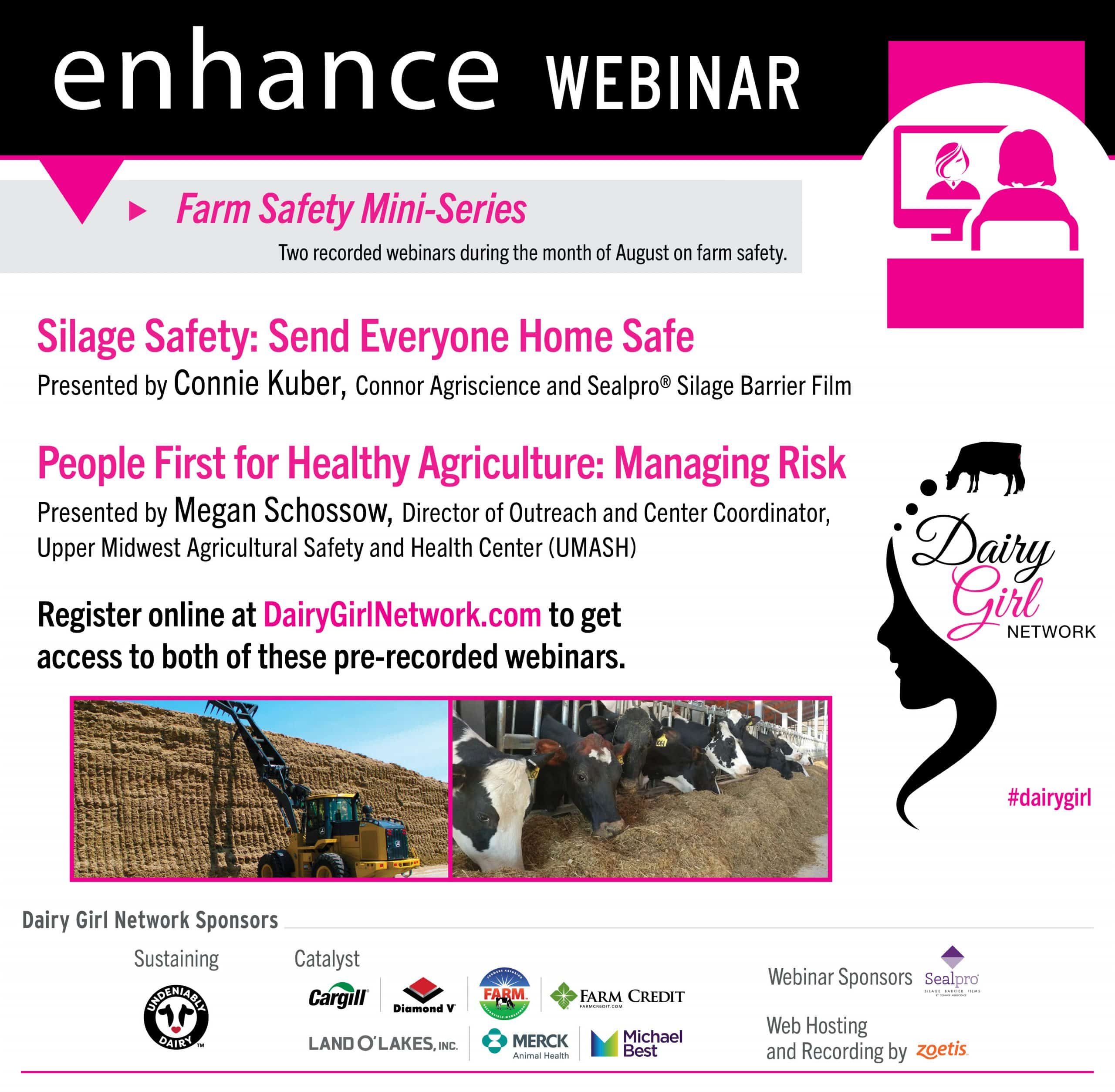August 2021
Dairy Girl Network (DGN) partnered with UMASH to host the second webinar in their August Safety Series for the DGN community. On August 25, UMASH’s Megan Schossow presented People First for Healthy Agriculture: Managing Risk. Megan discussed using an applied and practical approach to farm safety and health, while focusing on the Dairy Dozen, which are the 12 safety concerns on dairy farms. The webinar can be accessed at: https://dairygirlnetwork.com/farm-safety-series-registration/
 The Dairy Girl Network connects all women of the dairy industry, encouraging ideas and camaraderie in an effort to achieve personal and professional development. Designed as a welcoming network of passionate women involved in dairy, relationships will grow through shared experience, support and inspiration. Find more online:https://dairygirlnetwork.com/
The Dairy Girl Network connects all women of the dairy industry, encouraging ideas and camaraderie in an effort to achieve personal and professional development. Designed as a welcoming network of passionate women involved in dairy, relationships will grow through shared experience, support and inspiration. Find more online:https://dairygirlnetwork.com/
Latest News
- June 18, 2024Partnering for Progress in Agricultural Safety and HealthAt UMASH, collaboration is at the heart of what we do. Catch up on how UMASH is partnering to promote the health and safety of farmers, workers, and their families around topics like cannabis at work, emergency medical services, grain bin safety, and needlestick injury prevention. [...] READ MORE
- May 30, 2024Innovating for Agricultural Safety: Highlights from UMASH’s Spring 2024 GatheringAt UMASH’s 2024 Spring Center Meeting, UMASH researchers and staff gathered at Lake Elmo Park Reserve to share project updates, discuss new challenges, and strengthen partnerships to improve safety and health in the Upper Midwest. Joined by guest speaker Paul Aasen, CEO of the Minnesota Safety Council and UMASH Advisory Board Member, attendees networked, exchanged updates, shared successes, and brainstormed strategies to address emerging issues together. [...] READ MORE
- May 7, 2024Health Meets Harvest: Empowering Mayo Med Students in Ag MedicineUMASH, Mayo Clinic Alix School of Medicine, and Zumbro Valley Medical Society teamed up to create an agricultural and rural medicine elective for medical students. This course, led by Dr. Steven Kirkhorn and Dr. Jonathan Kirsch, addressed rural healthcare, including agricultural and migrant worker health, to help prepare future physicians serving rural communities. [...] READ MORE
- April 26, 2024Springing into Action for Ag Health and SafetySpring has sprung, and as farms are busy and in action with planting season underway, so is our UMASH team. From welcoming new faces, to raising agricultural safety awareness, catch up on what UMASH researchers and staff have been doing to help farmers, workers, and families stay safe and healthy this spring and all season long. [...] READ MORE
- April 3, 2024Safeguard your farm: Protect you and your livestock from HPAIHighly Pathogenic Avian Influenza (HPAI), also known as “bird flu,” is a serious, highly contagious disease that is often fatal to chickens and turkeys. To prepare for the possible infection of flocks in the Upper Midwest, UMASH has prepared a toolkit to help poultry farmers enhance prevention with biosecurity protocols, identify the signs and symptoms of HPAI in birds, and stay connected to additional resources from USDA – APHIS and state departments of agriculture. [...] READ MORE
- March 20, 2024Off-Road Ready: ATV/UTV Safety for Every RideWhile ATVs and UTVs can be enjoyable to drive and practical for work, the thrill of riding can turn dangerous, even deadly, if not handled with caution. Use these ATV and UTV safety tips to get off-road ready and gear up for a safe ride every time. [...] READ MORE
- February 28, 2024Welcome back, Cassie! A catch up Q&AUMASH welcomes Cassie Edlund back to the team as Senior Communications and Evaluation Specialist! Learn more about her journey, passion for public health, and commitment to promoting health and safety for agricultural communities through effective communication strategies and storytelling in this insightful Q &A. [...] READ MORE
- February 20, 2024Advancing Agricultural Safety in DCUMASH, MCOHS and other NIOSH Centers met in Washington, DC to discuss occupational safety and health research, training and outreach, focusing on advancing the well-being of workers in the agricultural sector, and workers across the US. [...] READ MORE
- January 18, 2024Possible or probable? MDH tracks potential farm-related injuries to prevent future risksDr. Erik Zabel studies health and safety on farms. In his work, he looks at data about injuries and illnesses from hospitals and clinics to understand which injuries likely happened on farms. Using hospital discharge data (diagnosis codes and e-codes), Erik is tracking farm injuries and working to develop a farm safety indicator. A farm safety indicator could be used to accurately track the number of farm injuries over time, which would provide insight into whether safety programs have helped reduce the number of injuries, create possible and probable safety and health categories, and target where workplace interventions may be helpful. [...] READ MORE
- November 29, 2023Honoring the Life of Carol PetersonAll of us at UMASH are deeply saddened to share that our dear friend and colleague, Carol M. Peterson, passed away November 19, 2023. Carol was a significant part of the UMASH team, and a gift to the agricultural safety and health community. We are deeply grateful for Carol’s impact and contributions, as well as the relationships and memories made along the way. [...] READ MORE
- November 22, 2023Fall ConnectionsNOVEMBER 2023 Autumn is a significant season in agriculture, and UMASH had an active month connecting with colleagues and FFA students and making new connections. Fraternizing at FFA UMASH & National Farm Medicine Center’s (NFMC) Scott Heiberger and Melissa Ploeckelman traveled to the 2023 National FFA Convention. Thousands of attendees, both students and advisors, get a front row seat to agricultural safety and health when they visit the NFMC booth, where farm safety jeopardy initiates conversations and resource sharing around farm safety. Making a splash at MRASH UMASH staff and researchers also gathered in Dubuque, Iowa, November 8-9, 2023, for the Midwest Rural Agricultural Safety and Health Conference (MRASH). UMASH’s work was presented to conference attendees, including a Telling the Story Project workshop and a poster on the Promoting Safety and Worker Health for Immigrant Dairy Workers research project. The National Farm Medicine Center was part of the MRASH conference with Dr. Florence Becot and her research project, which focuses on understanding the impact of individual and environmental influences on farmers and how likely they are to seek mental health support. Also attending was Jakob Hanschu from the Rural Firefighter Delivering Ag Health and Safety project, which has expanded internationally. Brief from the Board Our work is guided by the input of the UMASH Advisory Board, who represent many facets of Upper Midwest agriculture. On November 16, 2023, Advisory Board Members from South Dakota, Iowa, Wisconsin, and Minnesota gathered virtually to revisit UMASH’s activities over the past year, and discuss a variety of ongoing and emerging farm safety issues and priorities. The board members took this time to share the issues that keep them up at night and how UMASH can continue its work to promote agricultural health and safety to keep farm workers and families safe, and help us all sleep a little better! On the road again UMASH & National Farm Medicine Center’s (NFMC) Scott Heiberger and Melissa Ploeckelman attended the annual National Association of Farm Broadcasters conference in Kansas City, Missouri on November 15-17. This conference results in dozens of interviews, highlighting new resources and important information from the agricultural health and safety experts. We’re thankful for a community committed to the health of our agricultural workforce. Happy Holiday Season! [...] READ MORE
- October 31, 2023Scene and Herd in SeptemberSeptember was a busy month for meetings and presentations. The Ag Centers Safety and Health Summit in Marshfield, WI; the Auction of Champions at National Farm Medicine Center, and John Gibbins, DVM, MPH, dipl. ACVPM visited to UMASH and the University of Minnesota School of Public Health and College of Veterinary Medicine. [...] READ MORE


